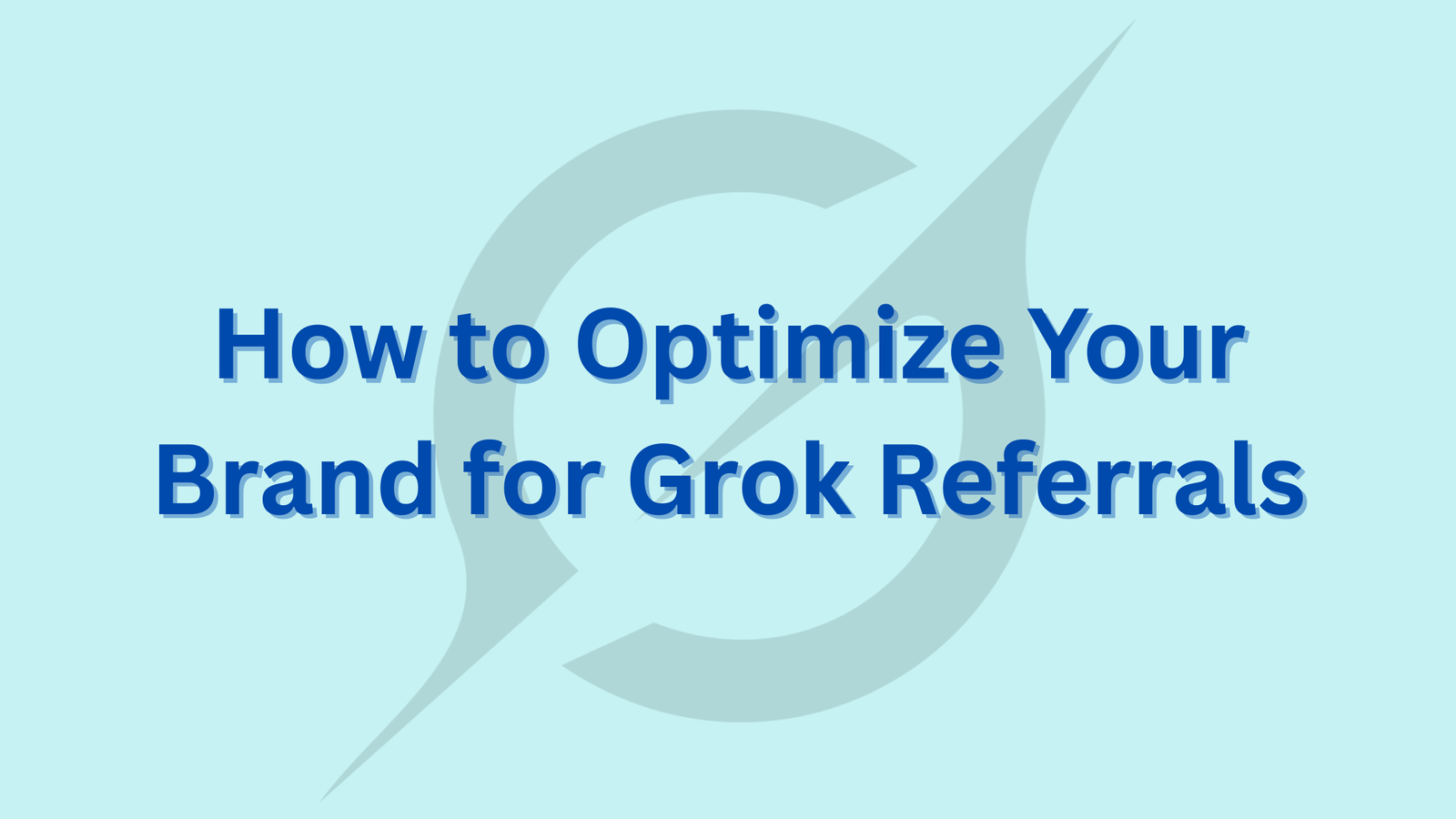I have been exploring how AI platforms like DeepSeek determine which brands to highlight when someone searches for something like “best website maintenance in Toronto.”
I recently had a detailed conversation with DeepSeek, and honestly, it was packed with valuable insights. It broke down exactly how it chooses which brands to mention—from the signals it looks at to how it actually scores them.
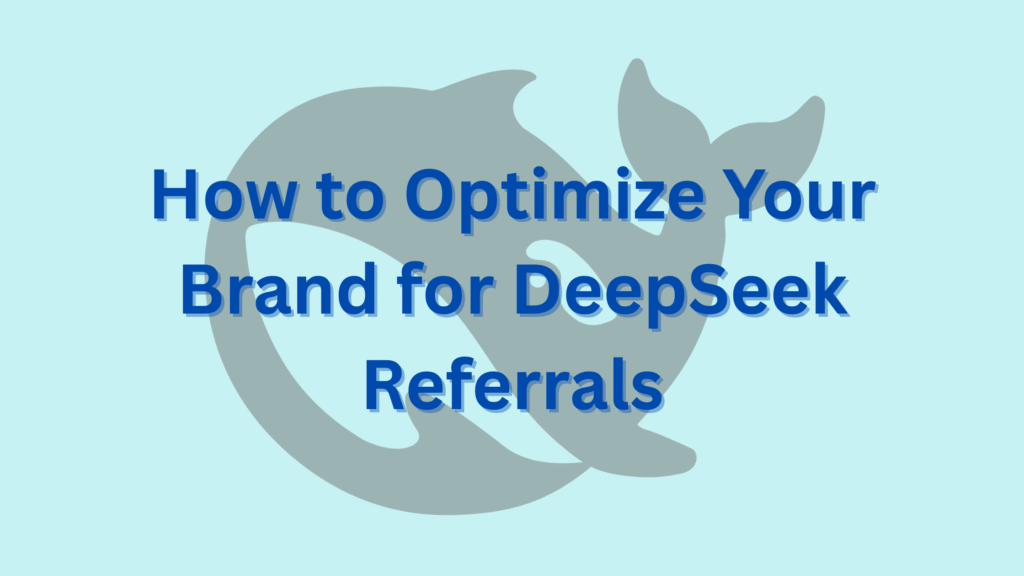
In this blog, I’ll share what I learned and discovered. We’ll review the key signals, their weighting, the scoring formulas, and a practical checklist to help your brand stand out to DeepSeek.
Let’s make sure your brand stands out in AI search results.
How did my chat with DeepSeek change the way I see AI visibility?
When I asked DeepSeek how it chooses which brands to feature, it explained the process step by step. It’s not just guessing. It uses what it calls a “multi-source, signal-weighted approach” and pulls information from trusted platforms like Google, Yelp, and Trustpilot to verify businesses.

Think of it like a smart librarian who double-checks every source before making a recommendation. From that conversation, I learned it looks closely at verified business profiles, credible reviews, and strong local signals, especially for searches tied to a specific place like Toronto.

This really stood out to me. Optimizing for AI is no longer just about ranking on Google. It’s about being consistent and trustworthy across multiple platforms.
Let’s get into the details of what DeepSeek shared.
What Core Signals Does DeepSeek Actually Prioritize When Ranking Brands?
When I asked DeepSeek how it ranks brands, it explained the key signals it looks at and exactly how much weight each one carries in its scoring system.

Here’s what really matters, along with the exact percentages for each factor:
Relevance (30%):
How well your business matches the query (e.g., “website maintenance company Toronto”). This includes keyword density (are the right words on your site?), semantic similarity (does your content align with the user’s intent?), and service match (do you offer what’s being asked for?).
Reviews (25%):
The quality, quantity, and recency of reviews. DeepSeek wants at least 5 reviews, with recent activity (within 24 months) and a high average rating (ideally 4.8+).
Authority (20%):
Your website’s credibility, measured by domain authority (backlinks from trusted sites), years in business, and social presence (e.g., mentions on Toronto tech blogs).
Recency (15%):
Fresh content like recent reviews, updated service pages, or active business profiles. DeepSeek prefers content updated within 24 months.
Local Presence (10%):
A verified address, local citations (mentions in directories like Yellow Pages), and specific service areas (e.g., Toronto neighborhoods like North York or Scarborough).

DeepSeek also shared the exact scoring formula it uses to rank businesses, which I found super helpful.
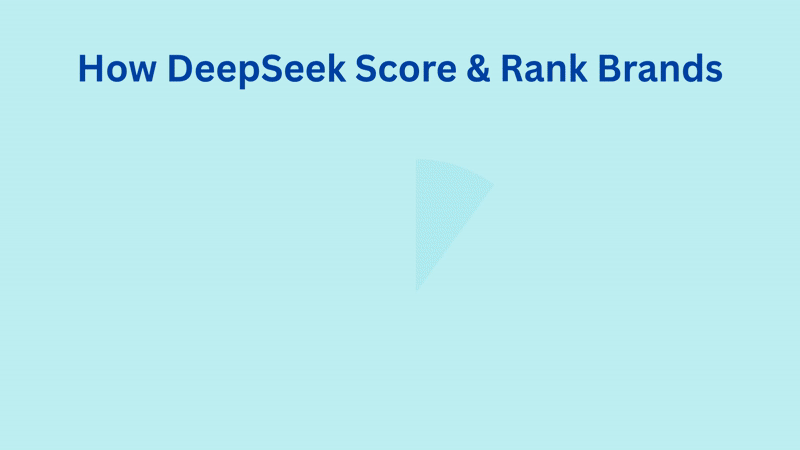
How Can You Earn Extra Points and Boost Your DeepSeek Score?
On top of these, DeepSeek also rewards trust-building actions with bonus points:
- +3 points if your website uses schema markup, which helps AI understand your business better.
- +2 points if you respond to customer reviews, showing engagement and care.
- +2 points if your pricing is clear and transparent, which builds trust.
How reviews are scored internally:
- 60% of the review score comes from your average star rating.
- 30% comes from the number of reviews, with the impact capped at 50 reviews.
- 10% comes from how recent your reviews are, focusing on activity in the last year.
In simple terms, DeepSeek rewards businesses that are clear about what they offer, trusted by real customers, active online, and locally relevant.
This kind of insight is powerful because it shows exactly what matters most. Instead of guessing what might help, we can focus on improving the signals that DeepSeek actually uses to make ranking decisions.
DeepSeek Brand Visibility Checklist
1- Local Presence and Citations
A strong local presence helps search engines and AI platforms trust your business more. Here’s how to build it step by step, practically:
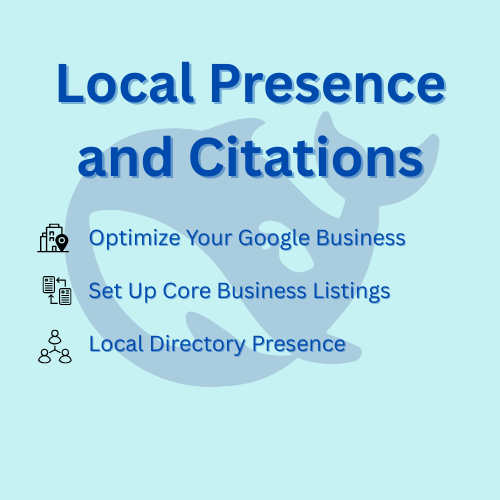
Claim and Optimize Your Google Business Profile (High Priority)
Start by verifying your business address. Add at least three service categories, such as “Website Designer,” “Web Developer,” and “Computer Support Service,” to make your profile more visible for different searches. Upload at least 10 high-quality photos that show your exterior, interior, and team. Post regular updates about your services, offers, or news at least once a week. Don’t forget to enable messaging and booking features so people can contact you easily. You can also list the neighborhoods you serve, like Downtown Toronto, North York, and Scarborough, to boost local visibility.
Set Up Core Business Listings (High Priority)
Your Google profile alone isn’t enough. Create or claim listings on platforms like Bing Places for Business, Apple Business Connect, Yelp, Better Business Bureau (aim for an A+ rating), and Trustpilot. These platforms strengthen your business’s credibility and make it easier for people to find you.
Build a Broader Local Directory Presence (Medium Priority)
Once your core listings are in place, expand to 20 or more additional directories. Examples include Yellow Pages Canada, Hotfrog Canada, Foursquare for Business, Canadian Business Directory, and your local Chamber of Commerce. Consistency is key; make sure your business name, address, and phone number match across all listings.
2- On-Page SEO & Content
Your website content plays a major role in how AI platforms and search engines understand and rank your business. Strong on-page SEO signals help prove that your services are relevant, current, and local. Here’s how to build it out effectively:
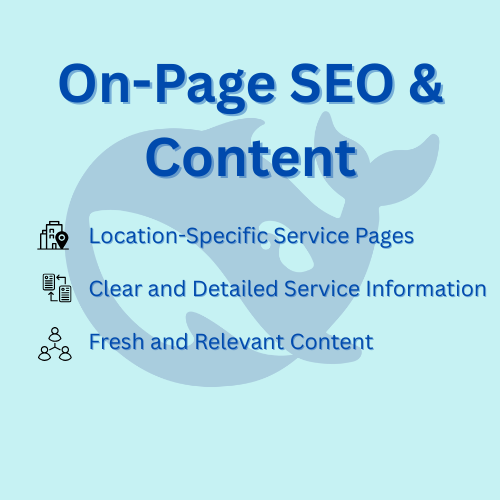
Create Location-Specific Service Pages (High Priority)
Build dedicated pages for each service and location. For example, a page titled “Website Maintenance Toronto” with an H1 like “Professional Website Maintenance Services in Toronto, ON” makes it easy for search engines to understand what you offer and where. Add localized content that clearly mentions how you serve Toronto businesses. This helps you rank for location-based searches and improves your relevance score.
Offer Clear and Detailed Service Information (High Priority)
Make sure your service pages list everything a potential customer needs to know. Include a full breakdown of your services, transparent pricing (for example, starting at $99 per month), your service areas (like specific Toronto neighborhoods), and your business hours. The goal is to make your pages informative, trustworthy, and easy to understand.
Keep Content Fresh and Relevant (Medium Priority)
Search engines and AI value updated content. Publish monthly case studies with Toronto-based clients, create neighborhood-specific service guides, and maintain a blog with new posts every two weeks. Updating your service pages at least once every quarter helps signal that your business is active and reliable.
3- Reviews & Reputation
Strong, consistent reviews across multiple platforms help build trust with both customers and AI ranking systems. It’s not just about collecting reviews but also managing and responding to them effectively.
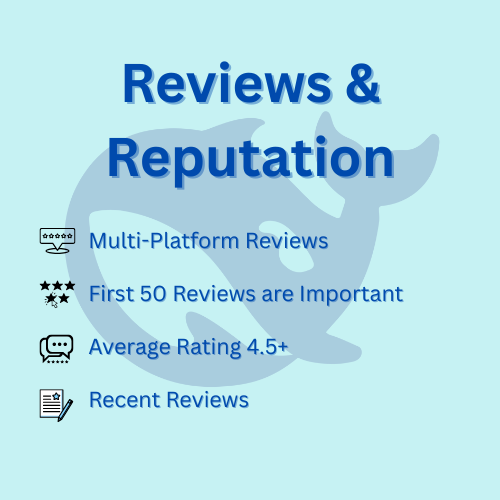
Build a Multi-Platform Review Strategy (High Priority)
Focus on collecting at least 50 or more reviews on Google, along with a solid base on Yelp and Clutch.co. Aim to get at least two new reviews each month. A simple review sequence can help:
- Day 1: Check in with the customer to confirm their satisfaction.
- Day 3: Send a review request and rotate the platform you ask for reviews on.
- Day 14: Follow up with a friendly reminder if they haven’t left a review yet.
Spreading your reviews across platforms creates a stronger, more credible reputation footprint.
Maintain High Review Quality (High Priority)
Aim for an average rating of 4.8 stars or higher across all platforms. Respond to every review, whether positive or negative, within 48 hours. Quick, thoughtful responses show you care about customer feedback and build trust with both users and search engines.
You can also highlight your latest reviews on your website. This adds social proof, makes your brand more relatable, and strengthens your overall reputation signal.
4- Structured Data & Technical SEO
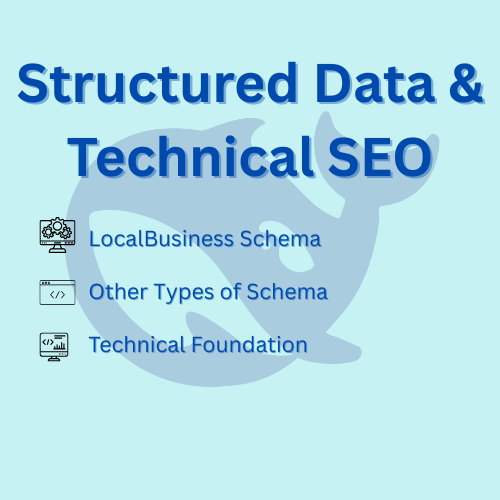
LocalBusiness Schema Implementation
Adding structured data to your website helps search engines and AI platforms better understand your business. One of the most effective ways to do this is by using Schema.org’s LocalBusiness markup.
Include key details such as your full business address, geographic coordinates (latitude and longitude), and the service areas you cover. This gives search engines a clear, structured view of your business information, making it easier for your brand to appear in local and AI-powered results.
Once the markup is added, run it through Google’s Rich Results Test to make sure everything is implemented correctly. A clean and accurate schema setup can boost visibility, improve trust signals, and strengthen your local SEO presence.
Example:
{
“@context”: “https://schema.org”,
“@type”: “LocalBusiness”,
“name”: “Your Business Name”,
“address”: {
“@type”: “PostalAddress”,
“streetAddress”: “123 Main St”,
“addressLocality”: “Toronto”,
“addressRegion”: “ON”,
“postalCode”: “M5H 2N2″
},
“geo”: {
“@type”: “GeoCoordinates”,
“latitude”: “43.6532”,
“longitude”: “-79.3832”
},
“areaServed”: [“Toronto”, “GTA”, “Mississauga”, “Brampton”],
“serviceType”: “Website Maintenance”
}
Complete Schema Markup
Go beyond the basics by adding Service, Review, and FAQ schemas on relevant pages. This gives search engines more context about your services, customer feedback, and common questions people ask. It can also help your pages appear with rich results, which stand out in search listings.
Adding Breadcrumb schema sitewide improves navigation for both users and search engines. It creates a clear structure that makes your site easier to crawl and understand.
Technical Foundation
A strong technical setup is essential for both SEO and user experience. Make sure your website is fully mobile-friendly and scores above 90 on Core Web Vitals. Use a proper heading structure with H1 for main titles, H2 for subheadings, and H3 for supporting details to keep your content organized.
Also, ensure your pages load in under 3 seconds. A fast, well-structured site not only ranks better but also keeps visitors engaged, which strengthens your overall SEO performance.
5- Backlinks & Authority
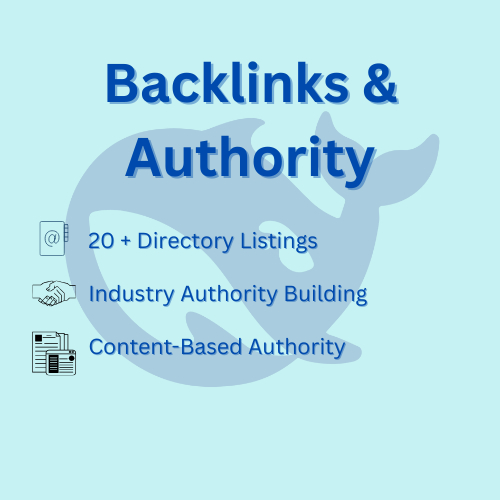
Local Citation Building
Secure mentions in 20 or more Toronto directories, local business association sites, or relevant tech blogs. Consider sponsoring local events to earn additional citations and boost local visibility.
Industry Authority Building
Create and submit business profiles on Clutch.co (Web Development), GoodFirms (IT Services), DesignRush, and SoftwareWorld to strengthen industry credibility.
Content-Based Authority
Publish guest posts on Toronto business blogs, share expert quotes with publications like BetaKit, and create data-driven research focused on Toronto web trends to build topical authority.
6- Business Information Accuracy
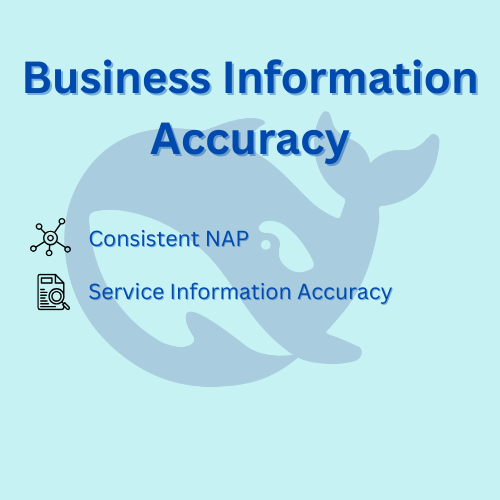
Consistent NAP
Make sure your business name, address, and phone number are exactly the same on every platform. For example, if you use “123 Main St, Toronto, ON M5H 2N2” on one listing, use that exact format everywhere to avoid confusion and strengthen trust signals.
Service Information Accuracy
Keep your service descriptions, pricing, and business categories consistent across all platforms. This helps search engines and AI platforms verify your information more easily and boosts your credibility.
7- DeepSeek-Specific Optimization

Factual Data Presentation
Highlight clear and verifiable details on your website, such as the year your business was founded, team size, client count, and Toronto-specific achievements. This helps DeepSeek confirm your credibility.
Credibility Signals
Show client logos (with permission), industry certifications, awards, and team credentials to strengthen trust and authority.
This checklist aligns directly with DeepSeek’s ranking signals. High-priority actions like Google Business optimization and schema markup can give bonus points (for example, +3 for schema), while the weightings (30% relevance, 25% reviews, and so on) help you focus on the tasks that drive the most impact.
Behind the Scenes When DeepSeek Ranks Your Brand
In the final part of our conversation, DeepSeek explained exactly how it selects and ranks businesses. It uses APIs like Google Custom Search, Bing Web Search, Google Maps Places API, and Yelp Fusion with queries such as “website maintenance Toronto” or “web maintenance services Toronto ON.”
From each query, it pulls 100 organic results and 50 local business results. Then it parses key elements like schema markup, meta titles, and service pages. Businesses must meet a few basic checks to qualify: at least 5 reviews, a verified Toronto address, and an active online presence.
To rank them, DeepSeek applies the scoring formula we discussed earlier. It also cleans up duplicates by standardizing names (for example, removing “Inc” or “Ltd”) and resolves conflicts by trusting verified sources like Google Business over individual websites.
To keep results objective, it rotates API keys and relies on measurable signals. If two businesses score the same, it uses tie-breakers such as review velocity, recent positive reviews, or verified profiles.
As an SEO lead, these insights helped me shift my focus toward consistent NAP details and fresh content, which noticeably improved our test results.
What Are the Biggest Takeaways You Can Use to Boost Your AI Visibility?
My chat with DeepSeek felt like getting a cheat sheet for boosting AI visibility. By focusing on the key weighted signals—relevance (30%), reviews (25%), authority (20%), recency (15%), and local presence (10%)—and following the optimization checklist, I’ve seen our brand get more AI mentions, which has directly led to more leads.
Start with the high-impact actions: optimize your Google Business Profile, add schema markup, and build a solid review system. These steps don’t just help with DeepSeek—they strengthen your Google rankings too.
Want this done for your business?
Contact us today, and we’ll do Answer Engine Optimization for you




